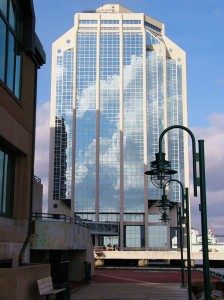More about specialty glass
The last post discussed two common types of specialty glass – patterned glass and tinted glass. Today, let’s look at two additional types of specialty glass – reflective glass and insulated glass – how they’re made and what they’re used for.
Two less common types of specialty glass
Reflective glass. Reflective glass is a specialty glass that features a reflective, transparent metallic outer layer. The coating reflects solar radiation and reduces the visible transmission (VT) of the glass. This reduces glare and the overall intensity of the transmitted light, but it also reduces the solar heat gain co-efficient (SHGC) of the glass.
In practical terms, this means reflective glass is better at keeping a room cooler during the summer than it is at preventing heat loss through the window during the winter. Reflective glass can make a significant contribution to reducing energy consumption in buildings that receive a lot of solar radiation – such as those in the Southwest.
Reflective glass also has “one-way” transmission properties. The glass is “see-through” in only one direction, so when used on the “skin” of a building, it offers privacy to the people inside, while still allowing light to pass through the glass.
The metallic layer in reflective glass is usually made of silver and a metal-oxide alloy, deposited in multiple separate layers. Reflective glass can be tempered, laminated and double-glazed. It’s important to remember that reflective glass is essentially a mirror and can focus (or intensify) the sunlight that hits it. In one instance, the reflected sunlight from a building in London was strong enough to damage vehicles parked nearby.
Insulated glass. Insulated glass is used in new and replacement residential windows. Insulated windows are made from multiple panes of glass that are bonded together in a single window frame. Usually a small space between panes is filled with ordinary air, or with an insulating gas such as krypton or argon. A triple-pane insulated glass window actually has 6 surfaces and two insulating spaces, which reduces heat losses and makes the window stronger.
Improvements in window technology are critical to achieving gains in the overall energy efficiency of homes and buildings. By combining specialty glass with different materials, glass coatings and construction techniques, engineers can significantly increase the energy efficiency of windows.
If you’d like more information about specialty glass and how Glassprimer™ glass paint can contribute to energy efficiency, please check out the rest of our site. If you’d like to purchase Glassprimer™ glass paint, please visit our online store .
Photo Credit: Bill Davenport, via FreeI

